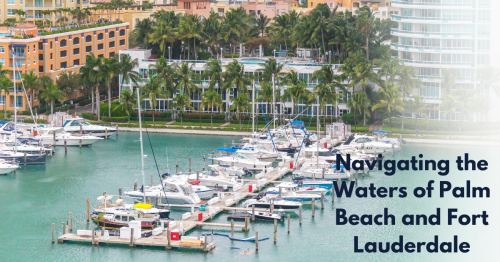Navigating the Waters of Palm Beach and Fort Lauderdale: A Boater’s Guide
Published May 7th, 2024

Palm Beach and Fort Lauderdale are celebrated for their expansive waterways, which offer everything from intracoastal cruises to deep-sea adventures. As premier destinations for boaters in South Florida, both locations boast a blend of luxurious marina facilities, vibrant marine ecosystems, and direct access to the Atlantic Ocean. Here’s how you can navigate these waters safely and make the most of your boating experience.
Understanding the Local Water Conditions
Navigating the waters of Palm Beach and Fort Lauderdale requires an understanding of the diverse conditions across different areas:
Busy Waterways: Both locations are known for their high volume of marine traffic, including yachts, fishing boats, and commercial vessels. This makes careful navigation and adherence to boating etiquette essential.
Intracoastal Waterway (ICW): The ICW runs through both Palm Beach and Fort Lauderdale. It is marked by a series of channel markers, and boaters should be familiar with the “red right returning” rule, which helps in maintaining the correct course when traveling north to south or vice versa.
Common Hazards
Strong Currents and Tides: The inlets connecting the ICW to the Atlantic Ocean, such as the Lake Worth Inlet in Palm Beach and the Port Everglades Inlet in Fort Lauderdale, can have strong tidal flows and shifting sands that create challenging conditions, especially for less experienced boaters.
Shallow Areas: Both areas have their share of shallow spots that can be hazardous. Boaters need to use updated charts and possibly even local pilotage services when navigating unfamiliar parts of these waters.
Manatee Zones: Environmental protection areas, particularly for manatees, are prevalent. Speed restrictions are enforced in these zones, and signage is clearly displayed to alert boaters.
Navigational Tips
Use Updated Navigational Aids: Ensure your vessel is equipped with up-to-date GPS systems and nautical charts. These tools are vital for navigating complex waterways and avoiding hazards.
Monitor Marine Traffic: Given the busy nature of these waters, using apps like AIS (Automatic Identification System) can help in tracking large vessel movements and managing navigation in crowded areas.
Local Boating Laws: Be aware of and comply with local boating laws and regulations, which can vary between Palm Beach and Fort Lauderdale, including speed limits and anchoring rules.
Weather Considerations
Weather in South Florida can change rapidly. Regularly check forecasts before and during your trip, especially during hurricane season (June to November). Quick-moving storms can produce high winds and rough seas, making it important to have a weather radio or an app that provides real-time updates.
Navigating the waters of Palm Beach and Fort Lauderdale offers a thrilling and rewarding experience for boaters. With the right preparation and knowledge of local conditions, you can enjoy everything these rich maritime communities have to offer, from serene intracoastal outings to exciting bluewater excursions.